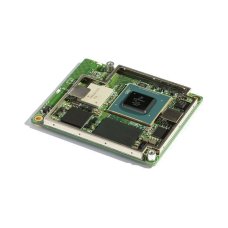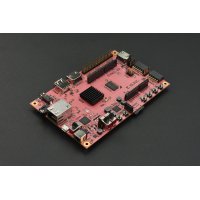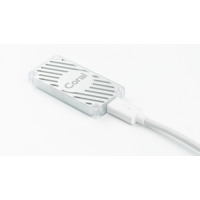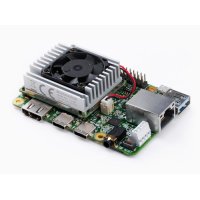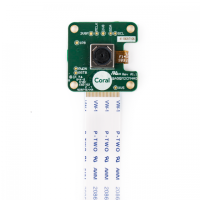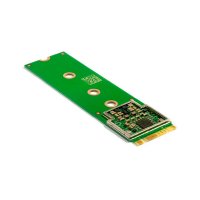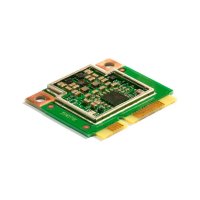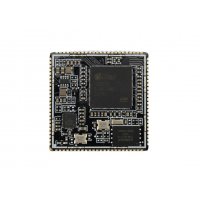- High-speed and low-power ML inferencing (4 TOPS @2 W)
- A complete Linux system (running Mendel, a Debian derivative)
- Small footprint (40 x 48 mm)
- Provides a complete system: The Coral SoM is a fully-integrated Linux system that includes NXP's iMX8M system-on-chip (SoC), eMMC memory, LPDDR4 RAM, Wi-Fi, and Bluetooth, and the Edge TPU coprocessor for ML acceleration. It runs a derivative of Debian Linux we call Mendel.
- Performs high-speed ML inferencing: The on-board Edge TPU coprocessor is capable of performing 4 trillion operations (tera-operations) per second (TOPS), using 0.5 watts for each TOPS (2 TOPS per watt). For example, it can execute state-of-the-art mobile vision models such as MobileNet v2 at 400 FPS, in a power efficient manner.
- Integrates with your custom hardware: The SoM connects to your own baseboard hardware with three 100-pin connectors.
- Supports TensorFlow Lite: No need to build models from the ground up. TensorFlow Lite models can be compiled to run on the Edge TPU.
-
Supports AutoML Vision Edge: Easily build and deploy fast, high-accuracy custom image classification models to your device with AutoML Vision Edge. Also available with a baseboard as part of the Coral Dev Board
- NXP i.MX 8M SoC
- Google Edge TPU ML accelerator
- Cryptographic coprocessor
- Wi-Fi 2x2 MIMO (802.11b/g/n/ac 2.4/5 GHz)
- Bluetooth 4.2
- 8GB eMMC
- 1GB LPDDR4
- USB 3.0
- Gigabit Ethernet
- HDMI and MIPI-DSI
- MIPI-CSI-2
- Up to 95x GPIO (including SPI, I2C, PWM, UART, SAI, and SDIO)
- 32 KB L1 Instruction Cache
- 32 KB L1 Data Cache
- Support L1 cache RAMs protection with parity/ECC
- 1 MB unified L2 cache
- Support L2 cache RAMs protection with ECC
- Frequency of 1.5 GHz
- 16 KB L1 Instruction Cache
- 16 KB L1 Data Cache
- 256 KB tightly coupled memory (TCM)
- Vivante GC7000Lite
- 4 shaders
- 267 million triangles/sec
- 1.6 Gigapixel/sec
- 32 GFLOPs 32-bit or 64 GFLOPs 16-bit
- Supports OpenGL ES 1.1, 2.0, 3.0, 3.1, Open CL 1.2, and Vulkan
- 4Kp60 HEVC/H.265 main, and main 10 decoder
- 4Kp60 VP9 and 4Kp30 AVC/H.264 decoder (requires full system resources)
- 1080p60 MPEG-2, MPEG-4p2, VC-1, VP8, RV9, AVS, MJPEG, H.263 decoder
- 2x USB 3.0/2.0 controllers with integrated PHY interfaces
- 1x Ultra Secure Digital Host Controller (uSDHC) interfaces
- 1x Gigabit Ethernet controller with support for EEE, Ethernet AVB, and IEEE 1588
- 2x UART modules
- 2x I2C modules
- 2x SPI modules
- 16x GPIO lines with interrupt capability
- 4x PWM lines
- Input/output multiplexing controller (IOMUXC) to provide centralized pad control
- Boot ROM (128 KB)
- On-chip RAM (128 KB + 32 KB)
- 32/16-bit DRAM interface: LPDDR4-3200, DDR4-2400, DDR3L-1600
- 8-bit NAND-Flash
- eMMC 5.0 Flash
- SPI NOR Flash
- QuadSPI Flash with support for XIP
HDMI Display Interface:
- HDMI 2.0a supporting one display up to 1080p
- Upscale and downscale between 4K and HD video (requires full system resources)
- 20+ Audio interfaces 32-bit @ 384 kHz fs, with Time Division Multiplexing (TDM) support
- SPDIF input and output
- Audio Return Channel (ARC) on HDMI
- MIPI-DSI 4 channels supporting one display, resolution up to 1920 x 1080 at 60 Hz
- LCDIF display controller
- Output can be LCDIF output or DC display controller output
- 1x SPDIF input and output
- 2x synchronous audio interface (SAI) modules supporting I2S, AC97, TDM, and codec/DSP interfaces
- 1x SAI for 8 Tx channels for HDMI output audio
- 1x SPDIF input for HDMI ARC input
- 2x MIPI-CSI2 camera inputs (4-lane each)
- Resource Domain Controller (RDC) supports four domains and up to eight regions
- Arm TrustZone (TZ) architecture
- On-chip RAM (OCRAM) secure region protection using OCRAM controller
- High Assurance Boot (HAB)
- Cryptographic acceleration and assurance (CAAM) module
- Secure non-volatile storage (SNVS): Secure real-time clock (RTC)
- Secure JTAG controller (SJC)
- ASIC designed by Google that provides high performance ML inferencing for TensorFlow Lite models
- Uses PCIe and I2C/GPIO to interface with the iMX8M SoC
- 4 trillion operations per second (TOPS)
- 2 TOPS per watt
- 1 GB / 4GB LPDDR4 SDRAM (4-channel, 32-bit bus width)
- 1600 MHz maximum DDR clock
- Interfaces directly to the iMX8M build-in DDR controller
- 8 GB NAND eMMC flash memory
- 8-bits MMC mode
- Conforms to JEDEC version 5.0 and 5.1
- Meets SD/SDIO 3.0 standard
- Runs at 4-bits SDIO mode
- Supports system boot from SD card
- 10/100/1000 Mbps Ethernet/IEEE 802.3 networks
- Reduced gigabit media-independent interface (RGMII)
- Wi-Fi 2x2 MIMO (802.11a/b/g/n/ac 2.4/5 GHz)
- Supports PCIe host interface for W-LAN
- Bluetooth 4.2 (supports Bluetooth low-energy)
- Supports UART interface
- Asymmetric (public/private) key cryptographic signature solution based on Elliptic Curve Cryptography and ECDSA signature protocols
- Baseboard connectors 3x 100-pin connectors (Hirose DF40C-100DP-0.4V)
- Antenna connectors 2x coaxial cable connectors (Murata MM8930-2600)
Package Includes :
- 1 x Coral System-on-Module (SoM)
Coral System-on-Module (SoM)
- Brand: Seeed Studio
- Product Code:Seeed-Coral-System-SoM
- Reward Points:133
- Availability:In Stock
-
रo 13,329.00
- Price in reward points:13329
Available Options
Related Products
PYNQ-Z2 Development Board
PYNQ-Z2 is a FPGA development board based on ZYNQ XC7Z020 FPGA, intensively designed to suppor..
रo 21,715.00
Coral USB Accelerator
The Coral USB Accelerator brings powerful ML inferencing capabilities to existing Linux systems. Fea..
रo 7,997.00
Coral Dev Board
The Coral Dev Board is a single-board computer with a removable system-on-module (SOM) that contains..
रo 17,329.00
Coral Camera Module
The Coral Camera is a 5MP camera designed for use with the Coral Dev Board, providing input for comp..
रo 2,665.00
Coral M.2 Accelerator B+M key
The Coral M.2 Accelerator is an M.2 module that brings the Edge TPU coprocessor to existing systems ..
रo 3,331.00
Coral Mini PCIe Accelerator
The Coral Mini PCIe Accelerator is a PCIe module that brings the Edge TPU coprocessor to existing sy..
रo 3,331.00
IDO-SOM2D02-V1-2GW SoM based on SSD202 SoC - 128MB DDR3 RAM and 2GB SPI Flash
IDO-SOM2D02-V1-2GW is an ultra-small SoM (System on Module) based on SigmaStar SSD202 SoC (Arm Cort..
रo 2,000.00

